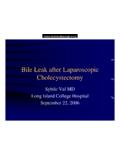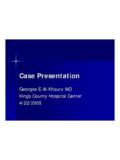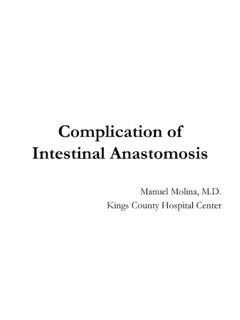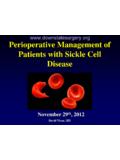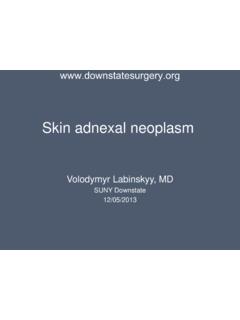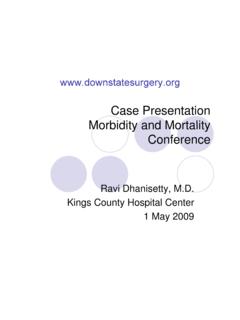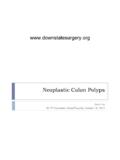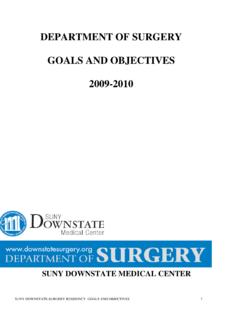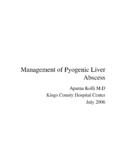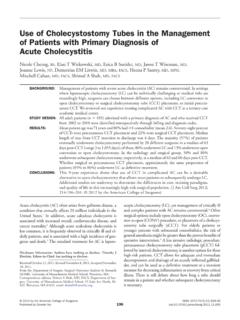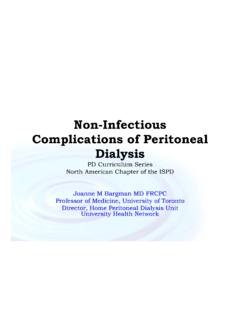Transcription of Bile Leaks After Laparoscopic Cholecystectomy
1 bile Leaks After Laparoscopic bile Leaks After Laparoscopic CholecystectomyCholecystectomyKings County Hospital CenterEliana A. Soto, MDBiliaryBiliaryInjuries during Injuries during CholecystectomyCholecystectomyzIn the 1990s, high rate of biliary injury was due in part to learning curve reviews by Strasberg et al. and Roslyn et al., the incidence of biliary injury during open Cholecystectomy was found to be review by Strasberg et al. in 1995 of more than 124,000 Laparoscopic cholecystectomies reported in the literature found the incidence of major bile duct injury to be surgeons passed through learning curve, have reached steady-state and there has been no significant improvement in the incidence of biliary duct of biliary injury when Laparoscopic Cholecystectomy is performed for acute cholecystitis is three times greater than that for elective Laparoscopic Cholecystectomy and twice as high as open Cholecystectomy for acute cholecystitis.
2 ZThe aberrant right hepatic duct anomaly is the most common most dangerous variant is when the cystic duct joins a low-lying aberrant right sectional duct. These injuries are underreported since occlusion of an aberrant duct may be asymptomatic and even of Laparoscopic Causes of Laparoscopic BiliaryBiliaryInjuryInjuryzFailure to properly occlude cystic to ducts in the liver bed is caused by entering a plane deep to the fascial plate on which the gallbladder of cautery may cause serious bile duct injuries with loss of ductal tissue due to thermal forcefully up on the gallbladder when clipping the cystic duct causing a tenting injury in which the junction of the common bile duct and hepatic duct is 1995.
3 Strasberg and Soper modified the Bismuth classification of bile duct injuries:zType A- bile leak from a minor duct still in continuity with the common bile Leaks occur at the cystic duct or from the liver B- occlusion of part of the biliary the result of an injury to an aberrant right hepatic 2% of patients, the cystic duct enters a right hepatic duct rather than the common bile duct-common hepatic duct junction. The aberrant duct may be a segmental duct, a sectoralduct (the right anterior or posterior duct), or even zType C- bile leak from duct not in communication with common bile duct.
4 Usually diagnosed in early postoperative period as an intraperitonealbile D- lateral injury to extrahepatic bile ducts. May involve the common bile duct, common hepatic duct, or the right or left bile duct. zType E- circumferential injury of major bile ducts. This type of injury causes separation of hepatic parenchyma from the lower ducts and duodenum. May be treated by percutaneous or endoscopictechniques depending on length of stenosis or if Classification of Biliary Duct Injuries:zMisidentification injuries: 2 main ) common duct is mistaken for cystic duct and is clipped and ) the segment of an aberrant right hepatic duct, between entry of the cystic duct and junction of the common hepatic, is mistaken to be the cystic intraoperative cholangiography-Fletcher et al.
5 In 1999 found that intraoperativecholangiography had a protective effect for complications of Cholecystectomy in a retrospective study of 19,000 cholecystectomies. zOperative cholangiography is best at detecting misidentification of the common bile duct as the cystic duct and will prevent excisional injuries of bile ducts if the cholangiogram is correctly interpreted. zPoor at detecting aberrant right ducts, which unite with the cystic duct before joining the common Management of bile Leak post Management of bile Leak post Laparoscopic Laparoscopic CholecystectomyCholecystectomyzIntraoper ative conversion of biliary injury is usually an indication for type D injuries are repaired by closure of the defect using fine absorbable sutures over a T-tube and placement of a closed suction drain in the vicinity of the D injuries that are thermal in origin or that are complex are best repaired by postoperative bile Leaks occur in up to 1% of patients undergoing Laparoscopic
6 Cholecystectomy compared to in open present within first week but can manifest up to 30 days After of bile LeaksDiagnosis of bile LeakszClinical manifestations of bile Leaks include abdominal tenderness, generalized malaise and drainage from drains placed at the initial of bile leak should be suspected whenever persistent bloating and anorexia last for more than a few days; failure to recover as smoothly as expected is the most common early symptom of an intraabdominal bile collection. zMinor bile leakage is common After open or Laparoscopic Cholecystectomy and is often related to disruption of small branches of the right intrahepatic duct entering the gallbladder Leaks , usually from the liver, occurred in 25% of 105 patients prospectively evaluated with ultrasonography by Elboim et Leaks may require no therapy, surgical placement of a drain at the time of the original procedure, or subsequent placement of a percutaneous drain for symptomatic bilomas that are recognized imaging (US/CT scan)
7 Is essential to define biloma that may require percutaneous or surgical scan may show presence of an active bile leak and general anatomic site of also provides imaging of the biliary tract, demonstrating dilation or stenosis of the biliary tract, and stones in the cystic duct remnant, the pancreas, and the pancreatic ducts; however, it does not allow concomitant therapeutic measures or physiologic assessment of bile flow (so cannot detect if a leak is active).zERCP and percutaneous transhepatic cholangiography (PTC) can provide an exact anatomical diagnosis of bile duct leak, while at the same time allowing for treatment of the leak by appropriate decompression of the biliary of bile LeaksTreatment of bile LeakszThe principle of treatment is to reestablish a pressure gradient that will favor the flow of bile into the duodenum and not out of the leak means removing any physiological or pathological obstruction such as the normal sphincter of Oddi pressure or a retained bile duct stone.
8 ZIn cases where there is a bile duct stone, removal of the stone with sphincterotomy is treatment of there is no stone, then internal stenting with or without sphincterotomy has shown to be effective in treating bile retrospective study by De Palma et al. in 2002 showed that sphincterotomy alone was highly effective in producing closure of bile fistulas by reducing endobiliary internal stenting is currently procedure of choice for treating bile duct Leaks (usually types A, C and D).z7Fr and 10 Fr stents can be inserted without prompt therapeutic response with cessation of bile extravasation in 70-95% of cases within a period of 1-7 the past, nasobiliary drains were used because they did not require sphincterotomy, and removal did not require second endoscopic , nasobiliary drains are poorly tolerated and they are not able to transport more than one-third of daily bile production which makes them less effective than internal method of non-surgical treatment of bile leak is PTC.
9 bile ducts are usually of normal caliber when there is leakage, which makes the procedure difficult. zPTC is usually reserved for instances when ERCP is unsuccessful or in preparation for surgical bile duct injuries are not easily accessible by the retrograde route. In certain instances, the distal part of the injured bile duct may be closed and ERCP, therefore, may fail to reveal any contrast extravasation. bile can thus continue to leak from the proximal part of the injury, and response to endoscopic treatment will be this case, PTC may be useful, or repair Histoacryl glue approved in Europe for the sealing of biliary fistulae; and botulinumtoxin injection to sphincter of Oddisuccessful in canine models.
